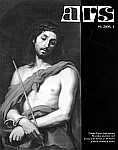
Časopis ARS 39 (2006) 1
Štefan ORIŠKO
Sigismundus Rex et Imperator. Úvahy nad výstavou umenia žigmundovskej doby[Sigismundus Rex et Imperator. Reflecting an Exhibition Dedicated to the Arts of the Era of the King Sigismund of Luxembourg]
(Resumé)
The primary goal of the international exhibition project Sigismundus – Rex et Imperator – Sigismund of Luxembourg, Arts and Culture 1387 – 1437 was to present the emperor, his life and activities in connection with the arts and culture. The exhibition, firstly presented in Szépművészeti múzeum in Budapest and then in Musée national d’histoire et d’art in Luxembourg (2006), was also aimed at his historical rehabilitation. Historiographies of the Central European countries where Sigismund once ruled, considered both the monarch and his era often very emotionally and with great differences. They also came into touch with nationalist prejudices and various ideological standpoints. Although this subject matter is relevant to the whole Central Europe, the intensity of interest it evokes in Central European countries is not the same. The theme was predominantly reflected by the Hungarian medieval historiography, where the actual exhibition wasn’t the first step in this direction. Its predecessor was the exhibition The Arts of the Era of the King Sigismund of Luxembourg 1387 – 1437, presented in Budapest in the year 1987 and connected to two anniversaries – 600 years from the King’s entry to the Hungarian throne and 550 years from his death. Although it couldn’t ignore international (European) context of Sigismund’s activities, it was primarily aimed at national (Hungarian) audience. The exhibition could lean on new findings of stone sculptures from the Buda Castle, where in the King’s Palace it also took place. The exhibition and studies in the catalogue indicated that Sigismund’s long reign wasn’t art historically uniform but amply stratified. There were the King’s court arts and regional developments, both reflecting actual international currents. It was also concluded that the King Sigismund’s era is in no case an art historical notion. The dates of his reign in Hungary don’t mark any significant ruptures neither in the history of Hungarian nor European arts. They mark a specific period in the political history, the reality of a distinct era and the historiography of arts can approach it via a more open study of relations among the history, culture and mentality rath¬er than via concentrating only on problems of style or stylistic periods. If the 1987 exhibition tried to rehabilitate and embody Sigismund and his era into the Hungarian context, then the actual 2006 exhibition undoubtedly tried to anchor him into European relations. The concept of the exhibition first appeared in minds of Ernő Marosi and Roland Recht and was then further worked on by an international team of specialist lead by Imre Takács. In separate chapters the exhibition presented Sigismund’s residences, the culture of the King’s court and its products, the Emperor‘s leading role in the European politics, his portraits and political heritage. The ending part of the exhibition was dedicated to the arts of the King Sigismund’s era in a broader meaning – to the arts of the International Gothic style. Presented artifacts often originated in regions outside the center, in border regions of medieval Hungary, but in touch with Central European currents in sculpture, table and book painting, textile art, goldsmithery etc. Imre Takács named this situation a historic handicap and peripheries without center. These phrases can be accepted: the arts of the so called peripheral regions didn’t follow only one center but many (and also different than Buda/Ofen). These arts could have been different in quality and demands from the center but – paradoxically – to a certain degree also equal. The goal of this important part of the exhibition was to present Central European context and a specific territory of the Hungarian Kingdom within it. This section had clearly an art historical character and can be taken as the first specialized attempt (although being an exhibition in an exhibition) to present the phenomenon of the arts around 1400 within mentioned geographical boundaries. Exhibited artifacts and the catalogue descriptions brought into light many new attributions and datings for art historians to deal with.